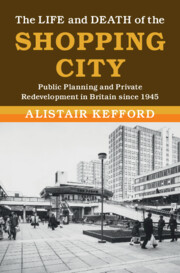 The Life and Death of the Shopping City
The Life and Death of the Shopping City Book contents
- The Life and Death of the Shopping City
- Modern British Histories
- The Life and Death of the Shopping City
- Copyright page
- Dedication
- Contents
- Figures
- Acknowledgements
- Introduction
- 1 Reconstructing Retail in the 1940s
- 2 Cities in the Age of Affluence
- 3 Making the Modern Shopping City
- 4 The Politics of Partnership
- 5 Landscapes of Leisure
- 6 Demand and Discontent in the Shopping City
- 7 Triumph of the Shopping City
- Conclusion
- List of Archives and Abbreviations
- Bibliography
- Index
1 - Reconstructing Retail in the 1940s
Published online by Cambridge University Press: 31 March 2022
- The Life and Death of the Shopping City
- Modern British Histories
- The Life and Death of the Shopping City
- Copyright page
- Dedication
- Contents
- Figures
- Acknowledgements
- Introduction
- 1 Reconstructing Retail in the 1940s
- 2 Cities in the Age of Affluence
- 3 Making the Modern Shopping City
- 4 The Politics of Partnership
- 5 Landscapes of Leisure
- 6 Demand and Discontent in the Shopping City
- 7 Triumph of the Shopping City
- Conclusion
- List of Archives and Abbreviations
- Bibliography
- Index
Summary
This chapter revisits the 1940s moment of urban and national reconstruction when the modern planning system emerged out of a tumult of ideas for the reformation of state and society. The 1940s saw the production of a wave of ambitious civic reconstruction plans, and these were often inspired by collectivist visions of social renewal, but the material presented here shows that reconstruction as it was actually practised focused overwhelmingly upon repairing the most valuable commercial districts of blitzed cities—the central shopping districts. I relate this pattern to the intensely productivist vision of reconstruction planning that emanated from central government at this time, as well as an engrained liberalism and administrative economism on the part of central officials. The new Planning Ministry placed supreme emphasis upon business growth and developmental needs while making strenuous efforts to rein in local planning ambitions and public spending commitments. The upshot of these agendas was a mode of reconstruction which aimed to grow the value and enhance the performance of central shopping districts, and planners worked closely with a range of commercial experts and interests to develop planning principles and policies that would maximise the efficiency of local retail environments.
Keywords
- Type
- Chapter
- Information
- The Life and Death of the Shopping CityPublic Planning and Private Redevelopment in Britain since 1945, pp. 29 - 64Publisher: Cambridge University PressPrint publication year: 2022
